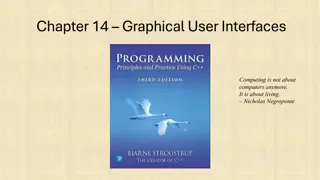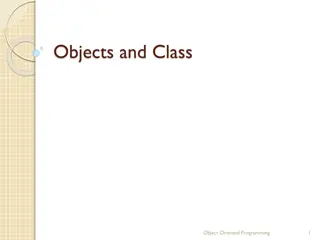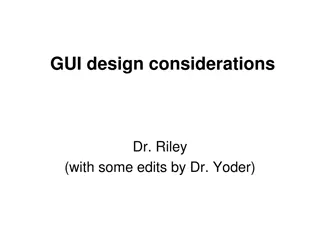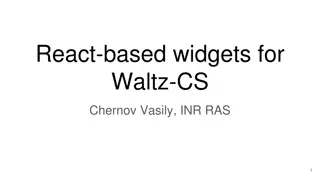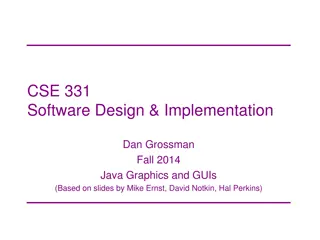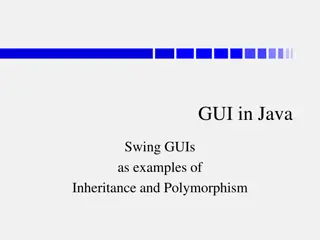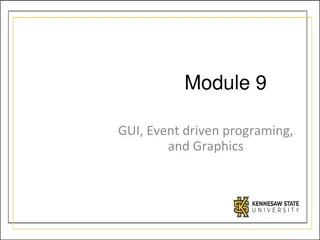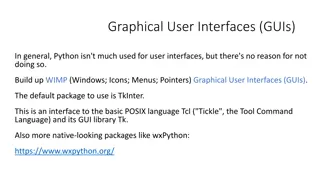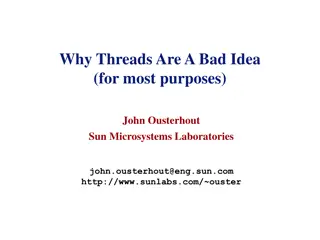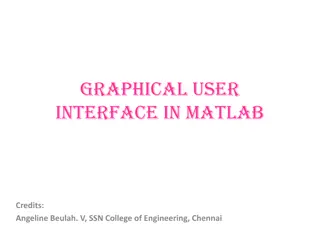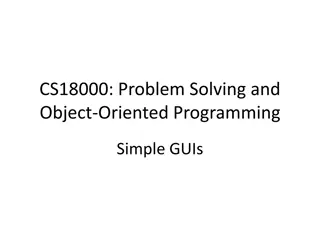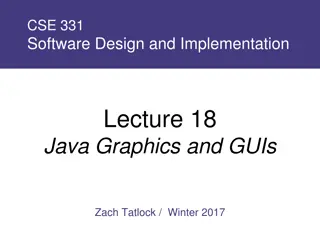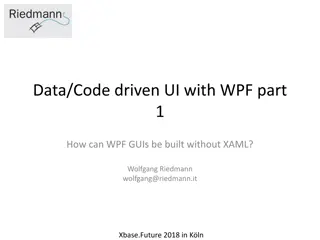
Understanding GUI Development in Java
Delve into the world of Graphical User Interface (GUI) development in Java, exploring the concepts of GUI vs. console-based applications, frameworks like AWT and Swing, and the essential components that form the foundation of Java GUI programming.
Download Presentation

Please find below an Image/Link to download the presentation.
The content on the website is provided AS IS for your information and personal use only. It may not be sold, licensed, or shared on other websites without obtaining consent from the author. If you encounter any issues during the download, it is possible that the publisher has removed the file from their server.
You are allowed to download the files provided on this website for personal or commercial use, subject to the condition that they are used lawfully. All files are the property of their respective owners.
The content on the website is provided AS IS for your information and personal use only. It may not be sold, licensed, or shared on other websites without obtaining consent from the author.
E N D
Presentation Transcript
If you want to discuss your Lab 2 see me this Office: 436 ERB. One hour prior to class Open to Appointments MWF I need the hours you spent on your Lab 2 Lab 3 will be graded soon Lab 4 will be assigned sooner Questions? How to Program Java By Deitel covers more GUI stuff than the text s listed on the syllabus Lab 2 grade come this week.
What are they? What s the difference between a GUI and a console based application? What is a framework? A process that uses specific objects Analogous to a car manufacturing process that uses specific car parts.
Answer: A bunch of objects!
Abstract Windowing Toolkit (AWT) Built on the native OS More flexible Faster Can be used in browsers without a java plugin Swing Newer built on AWT(ish). Made completely in Java More Portable Easier to use Can use the Model View Control design process
Swing is a platform-independent, Model- View-Controller GUI framework for Java, which follows a single-threaded programming model.[3] Components buttons, panels, dialog boxes, menus, text fields, and lists, are the visual widgets that respond to user actions Swing Components have, J in front of them JFrame JTextField Components appear in a container, which are themselves a type of component
The JComponent class is the root of the swing component hierarchy All swing components are subtypes of this except for top- level containers such as frames
When the button is clicked an Event Object is generated We handle this with an ActionListener Class
So far the Process is: Make a window (called a JFrame) Add stuff to that window Make the window visible (most important step) Create an ActionListener Register the ActionListener
Extend/make a JFrame Add a button Make an class that implements ActionListener Give that class to the button 1. 2. 3. 4. Sound good? Any Issues? Lets call our Jframe window And our ActionListener buttonListener How does the buttonListener access information/methods in the window object?
Pane A content pane is a container that is part of every Jframe object You cannot see the content pane and it does not have a border, but any object that is to be displayed in a Jframe must be added to the content pane Panel A panel is also a container that can hold GUI components Unlike Jframe objects, panels cannot be displayed by themselves commonly used to hold and organize collections of related components You can add a panel to the content pane (Like we did in the example) Effectively we added a panel to a pane
An event is an action that takes place within the program Pressing a button Hitting Enter in a text field An Event object contains information about the event The component that generated the event object is known as the Event Source Jbutton is an event source Can have multiple listeners Event objects are automatically passed, as an argument, to the method of the event listener This process is called Event Firing
An event source notifies a registered event listener by calling one of its methods (or event handlers) The specific event handler that gets called depends on the nature of the event (many event listeners define more than one event handler) An event object (that encapsulates information relating to the event) is passed to the event handler Using the information in the event object, the event handler method responds Every event object includes a getSource() method All event objects belong to subtypes of the java.util.EventObject class So what are some of the Event classes? Besides ActionEvent
How does the GUI component know to call action Performed rather than another method? Every GUI component supports several event types, including mouse events, key events and others. When an event occurs, the event is dispatched The private classes that implement the correct type and are properly registered are called
All event listener class must: Implement an interface Java provides numerous interfaces that you can use with event listener classes The specific interface that you will use depends on the type of event you want to handle Jbutton components generate action events, and the event listener class that can handle action events is also known as an action listener class When you write an action listener class for a Jbutton component, it must implement an Interface known as ActionListener What are some other interfaces?
Misspelling javax.swing in an import statement Forgetting to specify an action when the user clicks on the Event Source Remember that application is not terminated when you close or hide a Jframe. If you want to terminate the application, call setDefaultCloseOperation method and pass Jframe.EXIT_ON_CLOSE as the argument Forgetting to write an event listener for each event you wish an application to respond to Forgetting to register an event listener When writing an event listener method that is required by an interface, not using the method header specified by the interface
How do you do it? Setting it to null will allow you to program in absolute terms.
In one sentence what is a Framework? (Do not use an example) What is Swing? Does the order to which you add Java components matter in terms of how they are displayed? List everything that happens in a properly coded GUI program when a JButton is pressed (Use the example from last class) What are the three main Layout managers in Java?
In one sentence what is a Framework? It is a process that uses specific objects What is Swing? Java GUI Library Does the order to which you add Java components matter in terms of how they are displayed? Yes List everything that happens in a properly coded GUI program when a JButton is pressed (Use the example from last class) An event is created A registered What are the three main Layout managers in Java? Flow Border Grid It is a process that uses specific objects Java GUI Library Yes An event is created A registered ActionListener ActionListener object is called object is called Flow Border Grid

